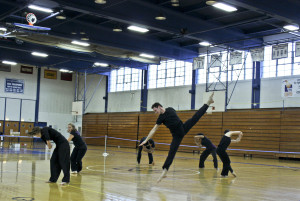By Julia Cinquegrani ’16, Campus Life Editor
 Stuart Pimsler ’71, founder of Stuart Pimsler Dance & Theater, and members of his dance company visited the College to perform, meet with classes, and hold a Common Hour presentation last week.
Stuart Pimsler ’71, founder of Stuart Pimsler Dance & Theater, and members of his dance company visited the College to perform, meet with classes, and hold a Common Hour presentation last week.
Pimsler’s Common Hour talk, entitled “Speaking Out! The Artist as Citizen/The Citizen Artist,” explored the role of the artist in the realm of public discourse and how dance can be used to comment on contemporary political and social issues.
In addition to Pimsler, eight dancers from his Minneapolis-based dance company performed and spoke at Common Hour. They also visited classes ranging from writing classes to government and dance classes, and they performed as a company in the Roschel Performing Arts Center on Saturday night.
Despite his devotion to dance, Pimsler majored in English at F&M and attended law school. After graduating from law school, however, Pimsler enrolled as an MFA Fellow in Dance at Connecticut College and has not looked back since.
Pimsler explained how his time at F&M made an impression on him and has been the impetus for much of his choreography.
“My time here really set the seeds for my work,” Pimsler said. “This kind of passion and energy and commitment to something really took a focus for me when I saw students become very involved in war that was happening in a land unknown to us and very far away.”
Pimsler discussed how the Vietnam War, which was occurring while he was at F&M, shaped his experience and made him aware of larger world issues.
“I’ll never forget being in Schnader dorm with my friends sitting around the television the first night the [Vietnam War] draft was televised,” Pimsler said. “We sat there, breathless. There were many people on campus who supported the war and many who did not. I watched many of my friends intentionally hurt themselves to try to get a deferment from the draft. A friend of mine put his arm on a table and asked another friend to jump on it so that it would be splintered.”
The Vietnam War clearly made a lasting impression on Pimsler, as the first dance he performed was entitled “The Peloponnesian Wars,” and he performed a segment focusing on the Vietnam War era. Audience members in Mayser Gymnasium could only sit in bleachers along the sides of the gym, to allow for Pimsler and his dancers to perform in the middle of the gym.
The second performance, “The Men from the Boys,” was choreographed by Pimsler in 1988 and performed by him and another dancer. This dance was also influenced by his time at F&M and images of the Vietnam War he saw in the media. Pimsler explained the dance as a metaphor for the ways people are affected by others in power and how power dynamics are constantly changing.
“I remember these moments as the beginnings of my sense of the larger world that I was seeing on TV being connected to what I was studying,” Pimsler said. “What was happening around me was impacting me and my classmates. It was about power, and we were powerless.”
During the performance the dancers continually shifted roles between being the controller or the one controlled, and themes of physical coercion, emotional connection, and violence were explored.
“Many of my friends were thinking about what they were going to do about the draft,” Pimsler said. “We would watch daily on the nightly news as planes returned from Vietnam and casket after casket was taken off the planes with American flags wrapped around them.”
The effectiveness of student protests against the war showed Pimsler how effective popular protests could be and motivated him to later use dance as a medium for expressing political dissension.
The third piece performed was an excerpt from “Ways to Be Hold,” which was choreographed by Pimsler in 2008 and continues his trend of commenting on warfare through art. It was inspired by his anger regarding America’s invasion of Iraq and was performed by eight members of Pimsler’s dance company.
Pimsler’s dance company is involved with community outreach and often works with members of the healthcare industry to use dance as a healing practice. The final dance performed included audience participation, and Pimsler often uses the dance when working with medical professionals to explore the doctor-patient relationship. At the beginning of Common Hour, six students and two faculty members volunteered to perform in the final dance, and, during the performance, each volunteer was paired with a professional dancer.
Pimsler has centered his work as a dancer around the idea that speaking out on political and social issues can make real change. He argued that the emotions involved in creating and viewing performance art can be much more powerful than simply talking about issues in more conventional ways.
“There is some kind of directness about the body saying something,” Pimsler said. “We don’t quite get it sometimes, but when we do understand it is direct and goes right to the place of emotional possibility.”
Sophomore Julia Cinquegrani is the Campus Life Editor. Her email is jcinqueg@fandm.edu.
